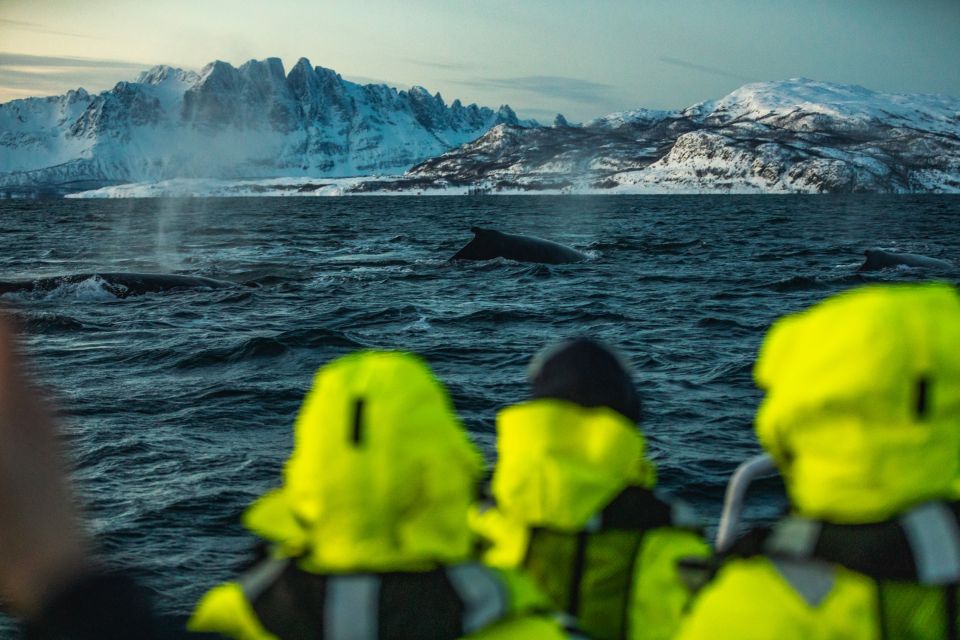Whale Watching in the Altafjord
Welcome to the captivating world of whale watching in Alta. From November to January, visitors to Alta have the chance to catch sight of orcas, humpback whales, fin whales and dolphins gracefully navigating their natural habitat as the herring is arriving in the Altafjord.
What sets Alta apart is the remarkable opportunity it offers since 2024 – the chance to swim with orcas. Embark on expedition boats equipped with experienced guides, and immerse yourself in the wonder of the Arctic waters,
Enjoy the best whale watching tours in Alta
Whale tour in Altafjord

Embark on an exhilarating whale watching tour in Alta Fjord, where recent sightings have brought humpback whales, killer whales, porpoises, and hourglass dolphins closer to our area. Experience the magic of witnessing these majestic creatures up close and be enchanted by the playful behavior of the younger whales.
About this activity
Highlights
– Cruise the Alta Fjord’s waters.
– Witness majestic sea mammals up close.
– Spot whales, dolphins, and porpoises!
Free cancellation
– Cancel up to 24 hours in advance for a full refund
Duration
– 4 hours
Tours provided in
– Norwegian, English
Small group
– Limited to 8 participants
Whale Watching RIB-boat

Winter brings whales to northern Norway’s herring-rich fjords, offering close encounters amid stunning scenery. Once aboard our RIB-boat, we navigate into the fjords, spotting humpback whales and Orcas while minimizing disturbance. Enjoy the thrill of observing these curious creatures swimming gracefully around our boat.
About this activity
Highlights
– Catch whales up close and personal
– Explore the Arctic Fjord and its marine wonders.
– Feel the thrill aboard a speedy RIB boat
Free cancellation
– Cancel up to 24 hours in advance for a full refund
Duration
– 7.5 hours
Tours provided in
– English
Small group
– Limited to 8 participants
Best time for whale watching in Alta?
The best time to go whale watching in Alta is from November to January. During this time, humpback whales and killer whales (orcas) migrate to the waters of the Altafjord to feed on herring. The peak season for whale watching usually coincides with the herring migration, which attracts these beautiful animals to the area in large numbers.

Tips for whale watching photography
Photographing whales during a whale watching tour can be an exhilarating experience. Here are some tips to help you capture stunning images:
- Use a telephoto lens: Since whales may not come very close to the boat, a telephoto lens will allow you to capture them from a distance while still filling the frame with your subject.
- Fast shutter speed: Whales can move quickly, so use a fast shutter speed to freeze their motion and prevent blurry photos. A shutter speed of at least 1/500 or faster is recommended.
- Continuous shooting mode: Set your camera to continuous shooting mode to capture a series of shots in quick succession. This will increase your chances of getting the perfect moment, especially when whales breach or surface.
- Consider the lighting: Pay attention to the lighting conditions, as they can greatly impact your photos. Try to shoot during the golden hours of sunrise or sunset for soft, warm light. Avoid harsh midday sunlight, which can create harsh shadows and overexposure.
- Focus on the eyes: When photographing whales, aim to focus on their eyes or the most expressive parts of their bodies. This helps create a connection between the viewer and the subject.
- Compose creatively: Experiment with different compositions to add interest to your photos. Include elements such as the ocean, other boats, or the coastline to provide context and perspective.
- Be patient and observant: Whale behavior can be unpredictable, so be patient and observant. Keep an eye out for signs such as splashing, blows, or dorsal fins, which indicate the presence of whales nearby.
- Respect the whales: Remember to maintain a safe distance from the whales and follow any guidelines provided by your tour operator or local authorities. Avoid disturbing or harassing the animals for the sake of a photo.
- Stabilize your camera: Use a tripod or stabilize your camera against a railing or your body to minimize camera shake, especially in rough seas.
- Capture the environment: Don’t forget to capture the beauty of the surrounding environment, including the sea, sky, and coastline. These elements can enhance the storytelling aspect of your photos and provide context to your whale watching experience.
By following these tips and staying patient and alert, you’ll increase your chances of capturing stunning photographs during your whale watching tour.
